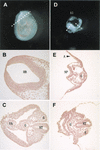G9a histone methyltransferase plays a dominant role in euchromatic histone H3 lysine 9 methylation and is essential for early embryogenesis
- PMID: 12130538
- PMCID: PMC186403
- DOI: 10.1101/gad.989402
G9a histone methyltransferase plays a dominant role in euchromatic histone H3 lysine 9 methylation and is essential for early embryogenesis
Abstract
Covalent modification of histone tails is crucial for transcriptional regulation, mitotic chromosomal condensation, and heterochromatin formation. Histone H3 lysine 9 (H3-K9) methylation catalyzed by the Suv39h family proteins is essential for establishing the architecture of pericentric heterochromatin. We recently identified a mammalian histone methyltransferase (HMTase), G9a, which has strong HMTase activity towards H3-K9 in vitro. To investigate the in vivo functions of G9a, we generated G9a-deficient mice and embryonic stem (ES) cells. We found that H3-K9 methylation was drastically decreased in G9a-deficient embryos, which displayed severe growth retardation and early lethality. G9a-deficient ES cells also exhibited reduced H3-K9 methylation compared to wild-type cells, indicating that G9a is a dominant H3-K9 HMTase in vivo. Importantly, the loss of G9a abolished methylated H3-K9 mostly in euchromatic regions. Finally, G9a exerted a transcriptionally suppressive function that depended on its HMTase activity. Our results indicate that euchromatic H3-K9 methylation regulated by G9a is essential for early embryogenesis and is involved in the transcriptional repression of developmental genes.
Figures








Comment in
-
Histone modification and replacement in chromatin activation.Genes Dev. 2002 Jul 15;16(14):1739-42. doi: 10.1101/gad.1013902. Genes Dev. 2002. PMID: 12130533 Review. No abstract available.
References
-
- Aagaard L, Laible G, Selenko P, Schmid M, Dorn R, Schotta G, Kuhfittig S, Wolf A, Lebersorger A, Singh PB, et al. Functional mammalian homologues of the Drosophila PEV-modifier Su(var)3–9 encode centromere-associated proteins which complex with the heterochromatin component M31. EMBO J. 1999;18:1923–1938. - PMC - PubMed
-
- Bannister AJ, Zegerman P, Partridge JF, Miska EA, Thomas JO, Allshire RC, Kouzarides T. Selective recognition of methylated lysine 9 on histone H3 by the HP1 chromo domain. Nature. 2001;410:120–124. - PubMed
-
- Boggs BA, Cheung P, Heard E, Spector DL, Chinault AC, Allis CD. Differentially methylated forms of histone H3 show unique association patterns with inactive human X chromosomes. Nat Genet. 2002;30:73–76. - PubMed
-
- Boon T, Cerottini JC, Van den Eynde B, van der Bruggen P, Van Pel A. Tumor antigens recognized by T lymphocytes. Annu Rev Immunol. 1994;12:337–365. - PubMed
Publication types
MeSH terms
Substances
LinkOut - more resources
Full Text Sources
Other Literature Sources
Molecular Biology Databases
Research Materials
